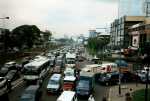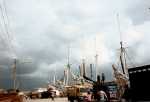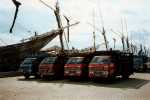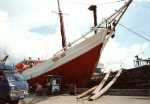INDONESIA
May / June 1995
Our trip through Java, Bali and Lombok...
Indonesia is the third biggest country in East Asia, more than 13.000 islands are scattered over an area of approx. 5.000 km. Not all of these islands are populated... The biggest ones among them are: Sumatra, Borneo (Kalimantan, the Indonesian part of Borneo) Sulawesi and Java, which are called the Big Sunda Islands, and the so called Small Sunda Islands: Bali, Lombok, Sumbawa, Flores, Sumba, Aduara, Lomblen and Alor, also known as Nusa Tenggara. Further there are Timor, the group of the Moluk islands and Irian Jaya (the Indonesian part of New Guinea).
The main part of the population is living on Java, more than 85 % of them are Islam. Apart from the Muslims, there are many immigrant Chinese people, some Hindus, some Buddhists and some Christians.
A considerable part of the Indonesian population still has ist own some natural religions, above all those people who are living in the unapproachable areas of Kalimantan, Sulawesi, Irian Jaya...
The more than 300 Indonesian populations have different culture levels, accordingly different languages and dialects. The official Indonesian language is the Bahasa Indonesia, which is also spoken in Malaysia as Bahasa Malaysia. Sometimes we wished to have learned some more Bahasa Indonesia, instead of learning only a few sentences, as communication in English was sometimes dificult.
Indonesia is a country of sharp contrasts: on the one side there have grown large industrial cities, such as Jakarta, Surabaya and Medan... On the opposite people cultivate even the slightest piece of ground along the streets or tracks, which is ploughed either by hand, or with buffaloes. Only some years ago some explorers discovered a tribe in Irian Jaya which did not know of fire, up to that date.
*****
The flight to Indonesia was exhausting and we were quite tired when we arrived at Jakarta airport. We took the first available Damri Bus to the Gambir station in the centre of Jakarta.
| The buses of the Damri Line are going once an hour during the rush hours from the airport to the Gambir (Main) station in the centre - price 3000 Rp (price 1995). |
After getting our bearings we entered the station and took the next train to Bogor, because we didn´t want to stay in Jakarta for the beginning of our holidays. The trains for Bogor leave also several times a day.
Bogor (the old Dutch name is Buitenzorg...) is situated in the mountains and, so we had been told, the temperatures are much lower and the mosquitos are fewer than in Jakarta. So, to get accustomed to the foreign climate and the new atmosphere it would not be so bad!
Bogor:
When we arrived in Bogor we were stressed and tired. A guide "caught" us at the station and brought us straight to the Ramayana Visma/ Guesthouse, a nice and quite favourable place. There we were supplied with Jasime tea and fresh pineapple. Later that evening we took a walk to explore the town...Bogor is a city with high traffic density, the streets are filled with noise and flooded with small motorbikes and Bemos. It seemed as if all kind of vehicles were squeezing through the streets without any rule or order. It was hot and the air was dusty.
The first night we shared our room with about 20 mosquitos, and despite of insect repellant and coils they bit us several times. Even hiding under thin covers was unsuccessful, and so Emilio woke up with a swollen eye as a mosquito had bit his eye lid. Next day we bought an adapter for our electrical "mosquito-killer".

In the morning we took an Indonesian breakfast in front of our room: Jasmine tea, toast with salty butter, honey and fresh fruits such as banana, papaya and pineapple...
It is worthwile to visit the Taman Safari Park near Cisarua, but if you organize the trip by yourself it won´t be so easy: provided that you have found the bus station in Bogor, you have to find the right bus...
"Ada bis ke Cisarua?" (Is there a bus to Cisarua?) The signs given by the man we asked meant: Somewhere overthere...! We saw about 20 buses, but somehow we were carried into a small Minibus. We noticed during our journey that Indonesian drivers have a style of driving which you have to get used to!
In this context, we also noticed a lot of crumbled wrecks of cars and buses along the street...
While we were talking to some Indonesian passengers who spoke broken English, the driver had some problems with the control lever of the gearshift. It began to detach and when it broke off we had to stop (compulsory) and the driver feched his tools and began to repair.
In Cisarua you have to catch another bus which will take you to the Safari Park, and over there a small bus will carry you through the open-air enclosure. In addition there is a Mini-Zoo where you can watch smaller animals and all kind of tropical birds. It was a very interesting day!
| Fauna: Like all tropical areas, Indonesia has a rich fauna. Although, caused by substantial deforestation, many of the species have been reduced to a minimum. On the bigger islands there are still some small species of tigers, like the Sumatra- and the Java-tiger (regional species) and the Sumatra-rhinoceros, a smaller relative of the huge Indian rhinoceros. Also threatened are the famous anthropoids, the Orang Utans (which means something like "forest men"). The Indonesian Panther is also smaller than its Indian and African relatives are. In comparison to these species the following are quite numerous: hoofed animals like the Indonesian wild ox, called Banteng, or wild boars like the Celebes Boar or the Babirussa. Futher there are small species of wild cats and "marten cats" like Binturongs and Lindsangs, all kinds of small and big monkeys, flying foxes and birds, of course (paradise birds, pigeons, small parrots and parrakeets etc...). |
Back to Bogor:
A further attraction is the botanic garden of Bogor. The 111 ha. area is situated in the centre of the city. It was founded in 1817 and is the biggest one in the southern hemisphere. (entrance fee: 500 rp. / price 1995) Besides the Rafflesia, the very famous, biggest flower in the world (its bloom has a diameter up to 90 cm, there is also a smaller species of 40 cm diameter), you will also be able to watch large flying foxes, which rest in the trees, head down, during the heat of the day. Further you will see giant ferns and big, coloured butterflies with large wings and really beautiful colours.In the evenings we often sat on the terrace of a Padang-Food-Restaurant and watched the traffic while we listened to the gamelan-music (typical Indonesian style orchestra music) they played from a cassette, every evening the same..., but when we left Bogor we missed that music!
*****
Pangandaran:
We decided to go to Pagandaran, a small village on the south coast of Java. So we asked in the tourist office for the best connection. They booked us a complete tour to Banjar with connection to Pangandaran at "Erney-Travel". (What a jolly name...)That evening we waited more than 1,5 hours for Erney-Travel to pick us up at the guesthouse. The driver had again such a style of driving that gave us a bad feeling in our stomach. When the Minibus was racing down the steep and winding pass I thought that we could come off the road in one of those narrow curves, although we both have traveled a lot and we had seen a lot of things up to then. However, the bus stayed on the road, but the driver was not really taken with the idea of changing gear and so he pressed the accelerator pedal down to its limit. The poor motor!
At least, they had given us a small box with food, but none of us, neither us, nor the Indonesian passengers seemed to be very hungry. I think we all had to suppress our sickness... Then there was a big noise and we had a puncture. But no one was surprised. It took a long time until they had repaired the tyre.
At about 03:30 we arrived at Banjar and the driver droped us somewhere in the night. It was a kind of lonely junction outside of Banjar (maybe the bus station?). It was dark and as nobody spoke English we were only told the direction from which the next bus should arrive. Then we saw the bus speed away and again we sat aside of the street with our baggage - alone and forsaken in the night!
It began to dawn when we heard some noise and a crowded bus came at high speed towards us... - braking fully - and in the twinkling of an eye our baggage was placed onto the top of the roof and we found a place inside of the bus, it was so crowded that one could not tip over... So the bus went on. The first sun rays coloured the sky with a pale red. On the right side we saw only forest, on the left, far away, the black shilouette of a volcano rising into a red sky.
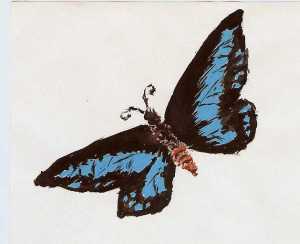
Especially in the area of Pangandaran we had the bad experience that people often demand double or triple prices for bus tickets, bemos and becaks. As we already pointed out in our Thailand report we can afford to pay some higher prices than native people, it wont´t hurt us and additionally even common people can also earn from tourism.
But, however certain relations should not be disregarded, and we see no reason why paying triplicate prices... And so we had a long discussion, but in the end we did not succeed.
When the bus dropped us finally at Pangandaran around 06:00 we took two becaks (the village is not situated directly to the road and so you have to walk maybe 1,5 to 2 km before you´ll reach the first hotels). We chose the Adams Guesthouse, but, however the Becak drivers seemed to have a contract with the Julie Beach Resort and brought us there. It was a pity, but worse that they tried to tell us that the names of the Guesthouses had been changed recently: We thought it a little bit expensive for us, but as we were so tired and urgently needed a bed, we agreed after having bargained upon a reasonable price (they reduced us the 21% tax, so they said)
Pangandaran is a beautiful village which is situated on the coast of a bottleneck which forms the connection between the mainland and a peninsula. The peninsula is a National Wildlife Reserve and can only be entered upon payment of an entrance fee and accompanied by an authorized guide, who can be hired at the entrance (price: 8000 - 9000 Rp. / in 1995).
Along the shore of the bottleneck the houses of the fishermen line up at one side, at the other shore the are small restaurants, bars and guesthouses. This is the tourist area, as many Indonesian tourists with money like to spend some holidays or even a weekend here. They mostly come from Jakarta or Bogor. But there are also a lot of European, Australian or American people.
After having had a few hours sleep we decided to take a walk on the beach. It was really beautiful...! Many palm trees in front of the Julie Beach, high waves surfed towards the beach, too dangerous to swim. Besides, we are no beach fans, although we like to walk along the shore, but we´d never expose ourselves to the sun in swimming costumes or take sunbaths...
Further we have to point out that people in this area are not accustomed to sun bathing tourists, and if they like to take a bath in the sea they do it dressed, with all clothes (especially women).
In order to visit the National Park of Pangandaran we had made an appointment with a young guide early in the morning, but he was unable to come. And so "Mr. Siswadi" offered his services to us....
At the entrance of the park a lot of small Java-monkeys were romping around. We wanted to see some of the wild Bantengs which use to come to their pasture area on a clearing, very early in the morning or just before sun set. When the sun rises high the Bantengs will withdraw into the shady forest.
| Bantengs are wild oxes which are still living on Java and Borneo. They are relatives of the huge Indian Gaur, but indeed they are smaller and not as heavy as the Gaur.. Cows and calves have a light-brown colour, bulls are coloured dark brown to black-brown. The legs and hindquarters are white. |
...we followed the guide who showed us different beautiful places. Siswadi, called "Sis" knows the small paths through the jungle very well. Sometimes we had to climb up rocks, sometimes we had to walk one after another through scrub and brush-wood. Sometimes we saw traces of dung of Binturongs, which seems to be something between marten and cat, and which is hunting at night. We saw giant, wonderful coloured butterflies, geckos, a large leguan (Iguana), small bats and large black apes which were jumping from tree to tree.
We enjoyed that jungle-trip with Sis so much that he offered to organize another trip for us by motorbike next day, and after having bargained upon a good price to the satisfaction of both sides, we agreed happily.
So we were shown the surrounding areas of Pangandaran: cacao plantations, the manufacturing of palm sugar, the manufacturing of Krupuk (an Indonesian crab-bread which is usually taken with each meal), the small fishing-village Batukaras, some beautiful beaches, lagunes and lakes, a functional bamboo bridge which was used by "small traffic" like bicycles and motorbikes. A boat trip through the Green Canyon was also included in the price. Another wonderful day went by!
Usually we spent the evenings walking through Pangandaran, taking some small dishes in one of the fish restaurants and later at night we watched the numerous stars in the sky in front of our small bungalow at the Julie Beach Resort. One evening we made the acquaintance of "Elli". She had a small stand at the beach, selling (warm) drinks. We sat down at her stand consisting of a big table full of bottles, Coca, juices, water, warm beer etc. Elli spoke a little broken English and so we learned that she was living alone and trying to gain her livings with the stand, as many Indonesian people do. We often decided to take a drink at her stand in the evening and she was always very happy to see us. We remember that she always spoke a lot, but we hardly understood anything.
*****
Although we enjoyed Pangandaran very much, we decided to travel to Yogiakarta soon.
So we had to get up at 05:00 h in the morning to catch the bus at 06:00h to Kalipucang. The estimated departure of the ship to Cilacap was 07:00 h, but indeed it didn´t leave before 8 o'clock.
(In travel agencies and restaurants in Pangandaran such complete trips to Yogiakarta are offered)
During our journey through Indonesia we learned that the estimated arrivals could easily delay between 1 and 3 hours. This fact should be considered if you have not yet booked accomodation for the night and if you´d like to find one before dawn.
Many people entered the boat and all the baggage was stored onto the stem area. So the boat was slowly chugging river downwards... through the muddy water of the river and along the densely wooded river banks. From Kalipucang to Cilacap it usually takes 4 hours.
Sometimes we could watch large herons and predatory birds moving in circles above the river, or fishing men in their wooden boats. Several times the boat stopped near some small villages, people were waiting on a wooden pear, bundles, bags and sacks of uncertain contents were loaded. We also passed a prisoners´ island. If you reach Cilacap, the bus will take another 4 hours to Yogiakarta ( if there is one...)
*****
Yogiakarta:
Yogiakarta is a quite big city in the centre of Java and it attracts many tourists. Some of the most important Buddhist and Hindu temple areas are situated near to Yogia.In our opinion the Becak drivers were quite obtrusive, sometimes we really had to shake them off... Yogiakarta is a very commercial city, everywhere people try to sell you something.
| In Yogia. there are two tourist areas where you can find any kind of accommodation, from very cheap to very expensive. The first area is situated in the north of the city at the Malioboro Road, the second area is in the south of the Kraton. We first tried the Bagus Guesthouse (bagus = good), which you can find at the Malioboro Gang I. It is simple and the prices are most favourable. There are many cheap and good restaurants around the area of Gang I and Gang II. In comparison the Padang food is quite expensive. |
Each Sunday morning there are presentations of traditional Indonesian dance in the Royal Palace, the Kraton. The dancing artists wear coloured costumes. But, most of the time they are not really dancing, but sitting on the floor and telling Indonesian stories. Their recitations (speaking parts) are accompanied by chorus and gamelan orchestra (typical Indonesian instruments). Each of their movements has a traditional meaning. These stories have their origin in epic poems like the Ramayana or the Mahabharata. They show the history of Javanese heroes and rulers.
On the bird market a large number of songbirds are offered for sale, but also chickens, ducks and flying foxes (but these ones were fated to end up in a cooking pot). In one remote corner of the market, cock-fights were held and private bets were made....
*****
Borobudur and Prambanan:
Borobudur is a Buddhist monument which is representing a huge stupa. It was built in the 8th century. At that time many Buddhist were driven out of India and they emmigrated to Java.The monument consists of three terraces and a central Stupa of 8 m height. The basis has a length of 123m, and the total height of the monument is 33 m. The lower terraces show many reliefs, totally 2500 pictures and representations. Several stairways lead up to the separate terraces, each stairway guarded by a lion statue. The lower terraces are constructed in a square form, the upper ones in circle.
In the three upper terraces there are 32, 24 and 16 Stupas and in each Stupa there is a Buddha statue inside. The reliefs are describing three phases: the first one is called Kamadhatu and it describes the life of the common people. The second part called Rupadhatu shows the life of the Bodisattvas and the third part, Arupadhatu, shows the Nirwana....
To get to Borobudur we had to get up very early in the morning once again. The bus to Muntilan was overcrowded, although it was just 07:00 a.m. (many Indonesians have to travel long distances every day to get to work...). In Muntilan we took a bus to Borobudur and then we took a becak which carried us to the temple area.
An English-speaking guide is included in the entrance fee. After our visit we took a horse cart which brought us to the bus station. The bus was ready for "take off" . It was so overcrowded that people were already squeezing out of the doors (which are not closed in Indonesian busses for this reason).
First we decided to wait for the next bus, even if for a long time, but someone decided to disregard our decision and we were stuffed into the bus! To avoid falling out of the bus we grabbed hold of anything tightly. Also other passengers clutched to everything that was within their reach: grips, door handles, passengers etc... At the next station further passengers were pushed into the bus and so we automatically were pushed into the bus to a safer place, some steps away from the opened doors.

The second big temple area which is near to Yogiakarta is called Prambanan. It was built by Hindus in the 9th century. Those Hindus immigrated some time after the Budhists from India and they brought their very own arquitectural style to Central Java. In the north east of the temple area some of these tapering buildings have completely been reconstructed, other ones are completely destroyed. These tapering towers are called "Candis" and they represent the residence of the Hindu-Gods on the Sacred Mount "Meru". This is also a reason for the pyramid-shape of the temple buildings.
Among the eight reconstructed Candis, the biggest three of them are devoted to the leading Gods Shiva, Brahma and Vishnu. Opposide them there are three smaller Candis devoted to their mounts.: these were Hamsa, the wild boar Brahma was riding on - the big riding bull of Shiva and, of course, Vishnu´s beast Garuda, the large bird of Heaven.
The Shiva-temple is the only one that has four entrances. In separate chambers there are statues showing the different appearances of Shiva, his wife Parvati and Shiva´s elephant-headed son called Ganesha. (It is difficult to understand that Hindu-Gods do not have only one face, but several identities which often mean contrary appearances.) So, Shiva is the God of destruction, but also of renewing and reviving. The other temples show statues of Vishnu, who is the protector and preserver of this world - and of Brahma, the God with three faces who created this world from his breath...
*****
In Prambanan and Yogiakarta we had the experience that people (mainly Chinese) asked us if they may take a photo of us. And so they positioned us between their family, children etc. to take the photo...
Maybe they wanted to show us as a kind of attraction to their relatives: "Have a look! We met some Long-Noses!"
We intended to hike up to the peak of Gunung Merapi, which is the biggest active volcano in the surroundings of Yogiakarta. But, however, Mount Merapi had a big eruption about three weeks earlier and so the complete area was declared a danger zone and no one was allowed to enter the volcano. But we could see the large column of smoke rising up from Merapi´s top, when the sky was clear.
So we had to make a quick decision for another tour and booked a complete tour to Bali with a stop at Mount Bromo, another active volcano (on Java there are many of them). We booked our tickets at Hotel Aziatic - the Indonesian boy at the counter was prepared to bargain for the price and so we got the tickets a bit cheaper (approx. 60.000 Rp.. hotel at Mt. Bromo and ferry to Bali incl.)
Next morning we waited for the bus at the Hotel Aziatic, it was only half an hour late. A "comfortable" Aircon-bus... - Unfortunately the aircondition of the bus had accumulated a lot of condensation behind the plastic covering, so that each time we braked the gathered water splashed onto the passengers sitting below! The situation was not very appealing to them, of course. Then, suddenly, we heard a noise, sounding like "plääng...!"... The mechanic was rummaging for his tools, but after a while he came back and said in broken English:
"Sorry..., Aircondition broken...!" (Yes, we have already noticed...).
So we opened some windows and continued the journey, which was much more comfortable. But, however, after a few kilometres the bus stopped again, the mechanic got out to check the pressure of the tyres. How curious! And after some kilometres the same procedure! What' s wrong? Then the bus finally stopped, because one of the inner twin tyres was flat and had to be changed. This took some time...
By the time the bus was jolting up the winding road to Mount Bromo, it had already grown dark. Our staying for the night was booked in the Bromo Homestay, including a late dinner. But when we sat down in the large dining-room we saw a rat running jauntilly towards the kitchen. Some of the guests were screaming and left their tables, but we were much too tired to think about that. And so we took our meal and went to bed.
*****
Trip to Mount Bromo:
We had to get up at 03:00 h in the morning and at 03:30 h a Minibus took us to the starting point of the walking tour. It was almost a mass migration, some people hired a horse, but most of them went by foot. So dozens of hiker went over the brink of the caldera, passed a sandplain, and climbed up to the crater of the volcano where a stinging smell of sulphur was emitted. It was still dark and the plain of the caldera was covered with a thick white mist. But, suddenly , the first sun rays were rising from behind the eastern mountains. They turned the sky and the mist into slight red colour, the same as the column of smoke which was rising from the crater. We could see more details of the surroundings now: breathtaking scenery, several small craters were rising from the mist covered plain. And at the skyline we could see Mount Semeru, another active volcano which emitted a smoke column every quarter of an hour.| This area is called the Tengger-Highlands. The religion of the Tengger is a mixture between Buddhism and Hinduism. When Islam was extended to Java in the 13th and 14th century, the ancestors of the Tengger withdrew into these highlands, at the foot of Gunung Bromo (2302m) and Gunung Semeru (3676m), which are the residences of their Goddesses. |
*****
We stayed some time on the top until most of the tourists had already gone back, so we could enjoy the silence and the wonderful scenery. We would have enjoyed it if we only had had some hours more, to travel by foot to Mount Semeru, but, unfortunately we had to catch the bus to Bali...
The price for the ferry boat (250 Rp. / 1995) was included in our ticket, as well as the bus which took us from Gilaminuk to Kuta and Ubud. It took almost an eternity to arrive at Ubud, and when we got out it had grown dark again. Soon we found a small room, near the Monkey Forest. We had a balcony and view onto a large garden. Each morning we had the typical breakfast with tea, pancake, bananas and fruit salad. We could watch some small, brown squirrels jumping from palm tree to palm tree, also several kinds of birds and some black giant-wasps, and from the neighbouring hut we heard the sound of a large gecko (Tokeh) each morning. One day I had to remove a very big spider from our bathroom (although it was bigger than the palm of my hand, I am sure that it was not a dangerous one). After I had caught it, it was set into the garden and there it stayed.
And one evening, we just wanted to take our dinner in one of the small, cheap restaurants, we had the oportunity to see one of the biggest butterflies in the world: as I do not know the English name for that kind of butterfly I'll indicate the latin name, at least, which is: Attacus Atlas Linnaeus, his wings have a width of approx. 25 cm... (Source: specialized literature about butterflies)
A walk through the outskirts of Ubud is worthwhile. Ubud is a small artists´ city which is situated in the middle of rice terraces. Everywhere you can see the light brown coloured Bali-cattle which has been raised from domesticated Bantengs, and, with a bit of luck, you will be even able to watch some small snakes.
Whilst Islam superseded the hindu-buddhistic empires on Java, Bali has kept a very special form of Hinduism, up to the present, which is called Agama Hindu Bali.
One of the most interesting sights of Ubud is the palace, which is situated at the main road, near to the tourist information. This beautiful and interesting area is free of entrance fees. Huge relief like grimaces step out of the walls and stare right into one's face. With their terrifying eyes and horrible fangs they are looking at you...
Many pavillons are decorated in this way - terrible looking masks, statues of curious animals, some of them seem to be half a lion half an eagle - other ones seem to be human beings with animal faces...In front of one of these temples we saw the coloured costumes of Barong and Rangda. Barong is a wild looking being with sharp tusks and shaggy hair. In spite of its terrible appearance it personifies the Good, as it is trying to kill the ugly, even more terrifying looking witch called Rangda. Rangda is the Demon of Death and personifies the Bad... In the evenings dances and other traditional shows are presented in this mystic atmosphere.
To explore Bali on our own we hired a motorbike for 15.000 Rp. (We noticed that people were not prepared to bargain, most of the time we had to pay the mentioned prices and only a very few times some of them gave us a reduction for the goods we wanted to buy or hire - well, the experiences we had on Java were not the same).
However, it is worthwhile to make some excursions to see the wonderful scenery of Bali. Our first trip went to the north of the island. Lake Batar and Gunung Batar, a volcano of 1717 m height. If you follow that lonely road you will soon see the shilouette of Gunung Abang in front of the blue sky. This volcano is 2153 m high, but, the highest volcano on the island is the majestic Gunung Agung in the east of Bali, 3142 m height.
Our motorbike was a 125 Yamaha with two-stroke-engine, but it burned almost more oil than gasoline. And so it happened that we bought some oil to avoid a greater damage. Actually, we were not so satisfied with the bike... When the road led up a very steep hill, I had to get off and Emilio tried to drive the bike up the hill, slowly, slowly and with a cloud of blue smoke behind!

One of the most important temples on Bali is Besakih, situated in the north of the island at a height of about 900 m. It's a lovely place in the hills and from a distance you can already see the typical roofs of Balinese temples. You are only allowed to enter the temple area with Sarong (the typical Balinese wrap-around skirt which is made of a simple length of cloth and which is worn by men and women, as well). We had already bought Sarongs in Ubud and wrapped the long piece of cloth around our hips, although it was a bit difficult. At the entrance they demanded a "free donation" from each tourist: we gave 10.000 Rp., and earned a somewhat offended look by the man at the counter: "Oh, only 10.000??? Please have a look..." (...and he showed us a book with entries of paid donations..) "other people gave up to 40.000 Rp!" But we thought that even for 10.000 Rp. you can buy a lot of things in Indonesia and refused further demands for a donation.
As it turned out tourists were allowed to visit the temple area, but they were forbidden to enter the temples themselves. This was only permitted for Hindus, which meant that European, American or Japanese looking people had to stay outside, even for 40.000 RP. donation! We had had a lot of better experiences in other countries, and were somehow disappointed. Here we realized that tourists often had to pay a lot, but adequate counter services were not given. ***
But, however, we had an interesting experience...: we saw the biggest spider we have ever seen in our life! It was even bigger than our (harmless) bathroom-spider. But people warned us not to move too close because it was dangerous. It had hung up its web like projecting arches between some trees.
The most interesting temple in the south is Ulu Watu. To get there we passed Kuta and drove along some small and lonely streets. Ulu Watu is situated on a small peninsula in the south of Bali. There are hardly any villages, but if you should require some fuel it's no problem... From time to time you'll find small nissen huts aside the street. They sell soft drinks like coke, water and even petrol. The petrol is mostly sold in one-liter-bottles. At the entrance of Ulu Watu you have to borrow a scarf, as it is not allowed to enter the temple area without. But, be careful! There are wild, sacred monkeys living in the temple area. They like to steal ear-rings, golden chains, and, even glasses! So it happened that one monkey jumped from a tree behind onto my shoulder and caught my glasses (I have had some bad experiences with monkeys, and they are really NOT my favorite animals!). However, when we finally found the glasses (which means that Emilio found them, 'cause I can't see anything without them) they were broken into two pieces! Well, that was the story of Ulu Watu...
Another interesting temple in the north of Kuta is Tanah Lot. It is also directly situated at the coast. The temple of Tanah Lot is built onto a small rock in the sea and can be reached only during ebb. On the way back to Ubud it was convenient to make a stop in Mengwi to visit the Candi Pura Taman Ayun which is situated in the middle of a small lake.
As we had only a short stop on Bali we soon took the ferry boat from Padang to Lombok...
*****
Lombok:
The small island of Lombok belongs to West-Nusa-Tenggara. Between Bali and Lombok there is the so called Wallace-Line which means a change of flora and fauna. Dry climate and subtropical vegetation are some features of that region. Even the fauna is a very specific one, a transition between South Asia and Australia.We have to point out that, despite the dry climate, we didn't feel it. When we arrived in Mataram one of those intense tropical rainstorms came down. We found a cheap room in the Astiti II in Cakranegara, aside of the big traffic. (The capital of Lombok is Mataram, but the cities Cakranegara in the east and Ampenan on the coast build almost one city with Mataram. So it is convenient to take one of the Mini-buses to visit Ampenan and take a walk on the coast).
Aside the street there is a small channel (or should I say a sewer?!?) On the other side of the channel there are a lot of simple eateries, small kitchens with some tables and corrugated-iron-roofs. Most of them offered simple dishes like spicy soups or grilled chicken. So one evening we decided to cross one of the narrow foot-bridges and sat down. Soon a friendly smiling woman served a lot of unknown spices, fresh soup, pieces of grilled chicken and some dips. Really delicious! But, what's that ?? Something fell from the ceiling into the soup. Aha... an army of ants was crossing the roof above our table, and, from time to time some of them fell down. We moved to the left, but without success. The ants seemed to be everywhere! So we had to blow the fallen insects from the table from time to time...
The later evenings we spent on the terrace in front of our room drinking Coke and awaiting the end of the rainstorms while we watched the small geckos (Dijaks) which hid behind the lamp and waited for Mosquitos. Our electrical Mosquito-killer was very useful, but the nights were uncomfortable and awkward. The first night I woke up and realized that some armies of ants were moving across my bed. And so I moved to Emilios bed (not because it would have been free of ants, but there were less than in my bed). And so we both shared one small bed awaiting the morning. And the morning came soon: at 03:30 h the first cock began to crow, followed by about thirty other cocks. Then the Muezzin began to sing the morning prayer and around 05:30 h the Indonesian people got up and began to work loudly and noisily.
We met two Germans who stayed in the same guesthouse and so we decided to rent a car to explore the centre of the island. We made a trip to one of the Sasak villages. The Sasak are one of the populations of Central-Lombok. The village consisted of several, partly straw covered huts - some water buffaloes were grazing near a small water hole. When we got out of the car we were immediately surrounded by children who tried to swap everything... Our trip went on to Mount Rinjani. Deep, cloudy forests cover the surrounding area of that volcano. The road was very hard for the rented vehicle. In the evening we arrived at Cakranegara and one of the numerous opticians was able to repair my broken glasses (up to then I had to be content with my sun-glasses).
The next day we rented a small motorbike again to make a trip to the peninsula in the south of Lember. A very deserted and quiet place. This time we took a Honda four-stroke which was much more to our convenience! Once you have passed Lember the road is leading along the coast, but there are only a very few small villages. The scenery is very beautiful, coloured in red, green and blue, and you can see some of the small Gili-islands in the south of Lombok...
*****
Back to Java:
To get back to Java we booked a cheap flight to Yogiakarta at Merpati Airlines, as the bus and the ferries would take too much time... The first flight started in Mataram with a small CN 235 driven by propeller and had to land in Denpasar on Bali. There we had to look for new boarding cards and had to change the plane. We queued at the Merpati counter and there was only one person in front. But the clerk had some kind of problem with the computer and so we had to wait. We noticed that our flight was not shown on the electonic indicator board, but no one at the counter could give us further information. We went to the information desk, but they had no idea...We went to the Merpati office and they told us: "Your flight has been cancelled!" "Ah, really!!!(How funny) And what shall we do now??!? And how can we get our baggage??" Answer: "No problem. Just ask at the Garuda counter" And so we did...
We hurried to Garuda Airlines and explained our problem. In no time the clerk of Garuda changed our tickets. "Sir, what about our baggage?" - "Oh, it is already in the plane..." - (unbelievable!!) But we have to hurry. The flight they booked us now, already had the last call when we were waiting at the Merpati counter. ...hectic rush... there was an announcement through the loud-speaker: "Mr Emilio, please come to gate 6" Uniformed and armed safety officers led us to the right gate. What a rush!. We finally took our seats in the plane! But, unfortunately it took another 30 minutes until the plane took off.
Our stay in Yogia was only one night, because the next morning we took the bus to the Dieng Plateau in the north of Java. Breathtaking scenery in the middle of volcanos and about 2000 m altitude. We had a beautiful view across the valley, on the horizon the elevations of the twin volcanos Gunung Sundora and Gunung Sumbing.
Dieng is a small tourist village with many guesthouses and small restaurants and shops. The Dieng Plateau was a marsh land but it has been partly drained. Some small temple ruins can be visited and there is also a small museum showing statues, pottery etc. that have been found in this area. But most interesting is a walk through the outskirts. At the Dieng Plateau there are still many active volcanos and the vulcanism can be felt everywhere! In the south of the Bima temple you can see cooking brooks, boiling pools of mud, hot springs (but too hot to bathe in!!)
We were fascinated by this strange atmosphere. The smell of sulphur filled the air and the wind blew the hot vapor over the stony soil. Once lost in such a cloud of vapor you have to take care not to step into one of these holes or to step into a cooking puddle. We saw the coloured lake of Telgada Warma, which has an insensive colour of blue, green and violett. It is surrounded by a lush green vegetation and could be somewhere in Canada or Scandinavia.
The night was cold and our simple room had no bathroom, which meant that next morning we had to wash outside with very cold water. After a small breakfast we walked to the cooking sulphur lake Kawah Silari and hiked to Sebungan. We had been told that Sebungan is the highest village of Java. (Just for fun we took a measurement of GPS-data: south 07° 13,907' east 109° 54,600' height 6997 feet)
*****
We were stressed and exhausted by the long journey and went again to Pangandaran to have some relaxing days at the coast. This time we chose the Bamboo Guesthouse which is much cheaper than the Julie Beach, and there is also a good standard service. We used to take our lunch in a small restaurant near the park: Gado Gado, a meal of vegetable and salad with the famous Indonesian peanut sauce. On our last days we saw one of the big geckos (Tokeh) sitting on a timber near our table. And in the evening we could watch a really magnificient spectacle: just after sunset, in the twilight we could see them... hundreds of large flying foxes on their way to the nearby fruit plantations. They crossed the red sky, slowly and without any hurry, like large migratory birds. We were fascinated!
*****
Our trip to Cirebon, north coast:
Very early in the morning - we took the overcrowded bus to Ciamis. We had to change the bus - the ticket collector led us to the most swinging and jinking places in the last row of the bus, our baggage was stowed under the seats. The bus sped away, the driver had to keep to the timetable. We had to pass several mountain ranges, the road wand towards the pass. We were jiggled and shaked in the last row. Our baggage had slipped from under the seats and was now somewhere else. But at the time we didn't think about that. I thought about the sickness in my stomach. I hoped to arrive before vomiting. But it seemed that even the native people didn't feel so well... The first one seemed to feel queasy, vomited in the middle of the bus. The bus stopped, the ticket collector got out to fetch some sand with a tray and covered the mess. The bus went on, but not more carefully. The next one became sick and started to vomit... Bus stopped, ticket collector got out etc... bus went on. This helped me to suppress my own sickness and suddenly I felt quite well (in comparison to the other passengers). The bus stopped the third or forth time now... Now it got really funny! At each hole in the road (and there were many of them) we had to take care not to be catapulted over the seats in front. (At fairs you have to pay a lot of money for merry-go-rounds, and that´s how we felt) However, at least we enjoyed it a lot. But when we arrived we felt somehow kind of giddy. The bus station of Cirebon is quite big and also confusing. We tried to find a bus for the city (which is about 6 km from the station) But it happened that we caught the wrong bus, and when we realized our mistake we got out immediately. We didn't want to try again, took our backpacks and went on foot.We arrived at our hotel (I do not remember the name), sweating and exhausted and needed a shower. The hotel seemed to be some kind of..., well..."very simple". But we wanted to relax! When I entered the bathroom to take the long expected shower I first had to clean the Mandi of dead spiders, mosquitos and live cockroaches!
After having fished all these animals out of the water basin I noticed that there wasn't any water to refill. What a pity!!! In order to save water they had closed the main tap...
In the evenings they placed a bottle of Baygon (a very strong insecticde) into our room, which made us suspicious. At night they switched off electricity and our mosquito killer failed, next morning we packed our backpacks and moved to the Asia Hotel, which is much more comfortable.
Cirebon is a small port on the north coast of Java, but not very touristic.The more brash and presuming are the becak drivers. We visited a 350 years old Chinese temple. An old Chinese man explained us some details. He knew a lot about Europe. He had known the Dutch colonial time in Indonesia and said that they had to learn everything about Europe at those times.
*****
Jakarta:
We took the train back to Jakarta, Gambir station, to spend our last holidays in the Indonesian capital. We found a nice, small room in the part of Jalan Jaksa, a very quiet part of the town, surrounded by huge skyscrapers.
What an atmosphere!!! The traffic is just overwhelming. And to cross a street in Jakarta is always an adventure. We walked a lot to get an idea of the dimensions of the city. We visited the National museum and Old-Jakarta which was the ancient Dutch capital of Batavia. As we like the atmosphere of harbours so we made a visit to the old harbour of Jakarta where the large wooden cargo sailing ships arrive to off-load their expensive cargo from Kalimantan: valuable redwoods destinated for export to Europe and USA.
We spent some wonderful weeks in Indonesia. And we saw a lot of things, wonderful sceneries, monuments, but also a lot of poverty and misery which we cannot ignore.
15 hours flight back to Europe, Paris Charles de Gaulle. We had an 8 hours stop. Enough time to spend a Sunday in Paris, the familiar feeling to be back in Europe. Half frozen we did some sight seeing, took a coffee at Monmartre and became accustomed to the European climate again, before we had to catch our plane to Düsseldorf/Germany ...
The end
© 1999/2012 Claudia Sancho Fotos: Emilio Sancho
Fotos:
Before opening a new image, please close the present one!Bogor:
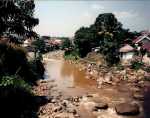
Pangandaran:

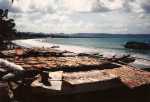
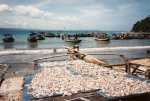

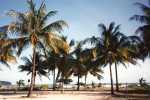
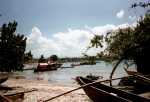



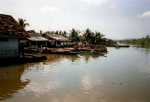
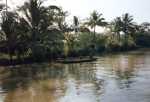
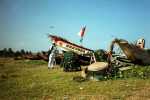

Yogiakarta:
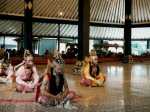
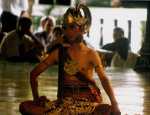

Borobudur:


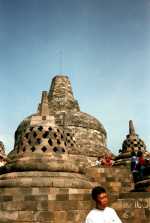
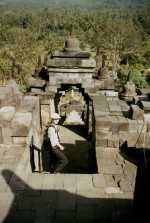
Prambanan:




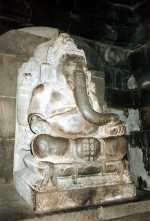
Mount Bromo + Mount Semeru:

Bali:



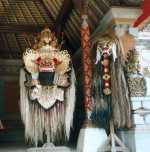

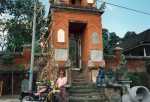
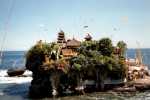



Dieng:


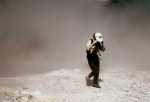



Djakarta:
